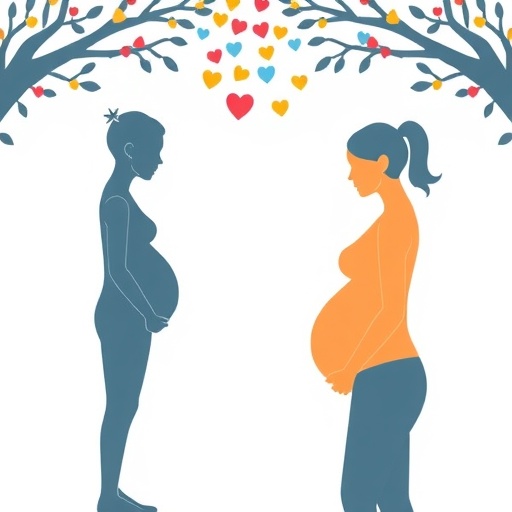In recent years, demographic research has increasingly focused on how changes in partnership dynamics influence fertility patterns across developed countries. A groundbreaking study published in Genus by Luppi, Migheli, and Pronzato (2024) sheds new light on the complex interplay between re-partnering and fertility outcomes. This research disentangles the effects of forming new unions after a separation or divorce on subsequent childbearing behavior, providing invaluable insights into modern family formation processes and shifting reproductive trajectories.
At the heart of this investigation lies the phenomenon of re-partnering, a demographic trend that has surged as divorce and separation rates have climbed globally. Re-partnering encompasses the formation of a new romantic partnership following the dissolution of a previous union. The study meticulously analyzes how these new partnerships influence the timing, likelihood, and quantum of fertility, revealing significant variation by age, previous fertility history, and socio-economic contexts. Importantly, the research highlights that re-partnering is not a mere demographic footnote but a critical driver of fertility patterns in contemporary societies.
Utilizing comprehensive longitudinal data sets spanning multiple countries, the authors employ advanced statistical modeling techniques to parse out the independent contribution of re-partnering to fertility outcomes. Their methodological approach controls for confounding factors such as education, income, and cultural norms, offering robust estimates of fertility changes attributable to repartnering. This careful analytical design lends considerable weight to their findings, challenging prevailing assumptions that view fertility primarily through the lens of first unions.
One of the most striking revelations from the study is the heterogeneity in fertility behavior following re-partnering. Women who re-partner tend to have significantly different fertility trajectories compared to those who remain single following union dissolution. Specifically, re-partnered individuals show a heightened probability of having additional children, although this effect varies substantially with age at re-partnering and the number of children from previous unions. This nuanced understanding underscores the importance of considering union histories in demographic fertility models.
The researchers also delve deep into the timing dimension of fertility post re-partnering, uncovering that childbearing is often accelerated within new unions. This accelerated timing suggests that forming a new partnership reinitiates reproductive intent and opportunity, creating a new temporal window for fertility. In contrast, those who do not enter new unions typically show a declining fertility propensity over time, indicating that re-partnering can reinvigorate childbearing potential at later reproductive stages.
Beyond individual-level factors, the paper explores macro-level trends, emphasizing how shifting social policies, cultural acceptance of diverse family forms, and economic incentives for childbearing modulate the interaction between re-partnering and fertility. It argues that these structural elements shape the context within which individuals form new unions and make fertility decisions, highlighting the interplay between agency and systemic forces in demographic processes.
Intriguingly, the authors incorporate a comprehensive gender perspective, examining how men’s and women’s fertility behaviors differ after union dissolution and subsequent re-partnering. Their analysis reveals gendered patterns in fertility resumption, pointing to broader societal dynamics, including differential parental responsibilities, economic roles, and biological constraints. Understanding these gendered nuances adds depth to demographic forecasting and social policy formulation.
This study’s implications extend beyond pure demographic theory; they hold significant relevance for policymakers aiming to address fertility decline in many industrialized nations. By recognizing the pivotal role of re-partnering in shaping fertility outcomes, policies fostering family stability and supporting diverse union forms may better align with contemporary reproductive behaviors, ultimately influencing population renewal dynamics.
Furthermore, the research challenges traditional demographic models that predominantly focus on first unions and overlook the cumulative fertility potential embedded in complex union histories. This work advocates for incorporating re-partnering dimensions into fertility projections to enhance their accuracy and relevance in capturing population trends amid evolving family structures.
Remarkably, the study also contributes to the understanding of the demographic consequences of relationship instability, elucidating how the dissolution and reformation of partnerships affect not only immediate fertility outcomes but also long-term population compositions. This perspective is vital for anticipating the needs and challenges of future generations within shifting societal configurations.
Apart from its theoretical advancements, the paper offers methodological innovations by integrating sophisticated event-history analyses and multi-state modeling, enabling a more granular examination of fertility dynamics across different partnership states. These tools open new avenues for demographic research to embrace the complexity of human life courses more comprehensively.
The authors further underscore the heterogeneity within re-partnering experiences, cautioning against one-size-fits-all interpretations. Factors such as socio-economic background, cultural context, and previous childbearing intricately condition fertility outcomes, prompting calls for intersectional approaches in demographic analyses and social policy designs.
In exploring fertility after re-partnering, the study also engages with broader questions about individual reproductive goals versus structural constraints, illuminating how personal decisions around family formation are embedded within wider social and economic matrices. This integrative perspective bridges micro-level behaviors with macro-level patterns, advancing demographic science’s explanatory power.
Finally, this pioneering research not only fills critical gaps in fertility studies but also equips governments, social scientists, and healthcare providers with a nuanced understanding necessary for designing responsive interventions. As societies continue to experience shifting relationship patterns, recognizing the fertility implications of re-partnering will be indispensable for sustainable population policies and family welfare strategies.
By putting re-partnering firmly on the demographic map, Luppi, Migheli, and Pronzato’s work heralds a new era of fertility research—one that embraces complexity, integrates diversity, and acknowledges that the pathways to parenthood are as varied as the lives people lead today.
Subject of Research: The influence of re-partnering on fertility patterns and outcomes.
Article Title: Re-partnering and fertility.
Article References:
Luppi, F., Migheli, M. & Pronzato, C. Re-partnering and fertility. Genus 80, 22 (2024). https://doi.org/10.1186/s41118-024-00227-y
Image Credits: AI Generated




